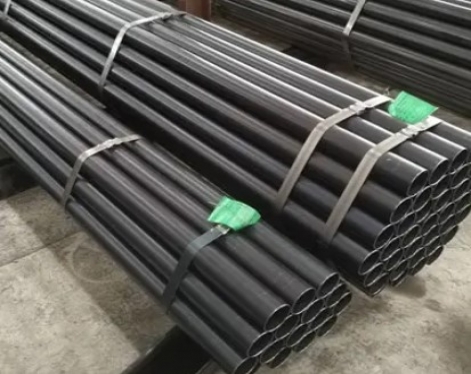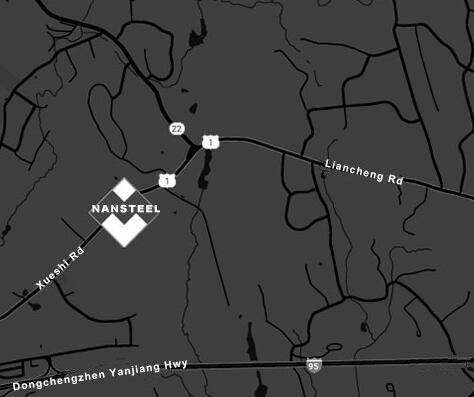Boiler tubes are essential components in boiler systems. Their quality and performance directly impact the operating efficiency and service life of the boiler. To ensure that boiler tubes remain in good condition during storage and avoid damage due to environmental factors or improper human operation, their storage conditions must be strictly adhered to. The following is a detailed description of boiler tube storage conditions:
Selection of storage environment
The storage environment of boiler tubes should meet the following requirements:
Dry and ventilated: Boiler tubes should be stored in dry, well-ventilated warehouses or sites to avoid humid environments. A humid environment can easily cause rust on the surface of steel pipes, especially carbon steel boiler tubes, whose surface easily reacts with moisture and oxygen in the air to form rust. If the storage environment humidity is too high, it is recommended to use dehumidification equipment or ventilate regularly.
Avoid direct sunlight: Boiler tubes should be kept away from prolonged exposure to sunlight, especially plastic-wrapped or coated steel tubes.
Ultraviolet rays in sunlight may cause packaging materials to age or coatings to degrade.
Keep away from corrosive substances: The storage area should be away from corrosive substances such as acids, alkalis, and salts to prevent chemical corrosion on the surface of the steel pipe. At the same time, avoid storing it in the same area with volatile chemicals.
Suitable temperature: The storage environment should be kept within normal temperature range, avoiding extreme high or low temperatures. Extreme temperatures may cause changes in the material properties of steel pipes, especially alloy steel boiler pipes.

Storage method
The storage method of boiler tubes is crucial to their protection. Common storage methods include:
Layered stacking: Boiler tubes should be stacked in layers, with wooden strips or rubber pads used to separate each layer to avoid direct contact between steel tubes and prevent surface scratches or indentations.
The stacking height should be determined according to the specifications and strength of the steel pipes to avoid deformation of the bottom steel pipes due to stacking too high.
Horizontal storage: For long boiler tubes, it is recommended to store them horizontally to avoid bending or deformation of the steel tubes due to hanging. At the same time, flat storage can reduce stress concentration on the steel pipe.
Vertical storage: For short or small-diameter boiler tubes, vertical storage can be used, but the bottom of the steel tube must be stable to prevent it from tipping over.
Avoid mixing: Boiler tubes of different materials, specifications and uses should be stored separately to avoid confusion. For example, carbon steel boiler tubes and stainless steel boiler tubes should be stored separately to prevent the materials from affecting each other.
Packaging and protection
Boiler tubes should be properly packaged and protected during storage to protect their surface and performance:
Anti-rust treatment: Before storage, the surface of the boiler tube should be treated with anti-rust treatment, such as applying anti-rust oil or anti-rust paint. For steel pipes stored for a long time, it is recommended to regularly check whether the anti-rust layer is intact and re-treat it if necessary.
Packaging materials: Boiler tubes should be wrapped with waterproof and dustproof packaging materials, such as plastic film, woven bags or moisture-proof paper. For boiler tubes with high precision or special purpose, it is recommended to use wooden boxes or iron boxes for sealed packaging.
End protection: The ends of boiler tubes should be protected with plastic or metal caps to prevent dust, moisture or foreign matter from entering the tubes.
Regular inspection and maintenance
During storage, boiler tubes should be regularly inspected and maintained to ensure they are in good condition:
Appearance inspection: Regularly check the surface of the boiler tubes for defects such as rust, scratches, indentations, etc., and deal with any problems in a timely manner.
Anti-rust layer inspection: Check whether the anti-rust oil or anti-rust paint is intact. If it falls off or becomes ineffective, it should be reapplied in time.
Stacking status inspection: Check whether the steel pipes are stacked firmly to avoid deformation or tipping of the steel pipes due to improper stacking.
Environmental monitoring: Regularly monitor the humidity, temperature and air quality of the storage environment to ensure that storage requirements are met.
Read more: International Standards for Boiler Tubes
Selection of storage environment
The storage environment of boiler tubes should meet the following requirements:
Dry and ventilated: Boiler tubes should be stored in dry, well-ventilated warehouses or sites to avoid humid environments. A humid environment can easily cause rust on the surface of steel pipes, especially carbon steel boiler tubes, whose surface easily reacts with moisture and oxygen in the air to form rust. If the storage environment humidity is too high, it is recommended to use dehumidification equipment or ventilate regularly.
Avoid direct sunlight: Boiler tubes should be kept away from prolonged exposure to sunlight, especially plastic-wrapped or coated steel tubes.
Ultraviolet rays in sunlight may cause packaging materials to age or coatings to degrade.
Keep away from corrosive substances: The storage area should be away from corrosive substances such as acids, alkalis, and salts to prevent chemical corrosion on the surface of the steel pipe. At the same time, avoid storing it in the same area with volatile chemicals.
Suitable temperature: The storage environment should be kept within normal temperature range, avoiding extreme high or low temperatures. Extreme temperatures may cause changes in the material properties of steel pipes, especially alloy steel boiler pipes.

Storage method
The storage method of boiler tubes is crucial to their protection. Common storage methods include:
Layered stacking: Boiler tubes should be stacked in layers, with wooden strips or rubber pads used to separate each layer to avoid direct contact between steel tubes and prevent surface scratches or indentations.
The stacking height should be determined according to the specifications and strength of the steel pipes to avoid deformation of the bottom steel pipes due to stacking too high.
Horizontal storage: For long boiler tubes, it is recommended to store them horizontally to avoid bending or deformation of the steel tubes due to hanging. At the same time, flat storage can reduce stress concentration on the steel pipe.
Vertical storage: For short or small-diameter boiler tubes, vertical storage can be used, but the bottom of the steel tube must be stable to prevent it from tipping over.
Avoid mixing: Boiler tubes of different materials, specifications and uses should be stored separately to avoid confusion. For example, carbon steel boiler tubes and stainless steel boiler tubes should be stored separately to prevent the materials from affecting each other.
Packaging and protection
Boiler tubes should be properly packaged and protected during storage to protect their surface and performance:
Anti-rust treatment: Before storage, the surface of the boiler tube should be treated with anti-rust treatment, such as applying anti-rust oil or anti-rust paint. For steel pipes stored for a long time, it is recommended to regularly check whether the anti-rust layer is intact and re-treat it if necessary.
Packaging materials: Boiler tubes should be wrapped with waterproof and dustproof packaging materials, such as plastic film, woven bags or moisture-proof paper. For boiler tubes with high precision or special purpose, it is recommended to use wooden boxes or iron boxes for sealed packaging.
End protection: The ends of boiler tubes should be protected with plastic or metal caps to prevent dust, moisture or foreign matter from entering the tubes.
Regular inspection and maintenance
During storage, boiler tubes should be regularly inspected and maintained to ensure they are in good condition:
Appearance inspection: Regularly check the surface of the boiler tubes for defects such as rust, scratches, indentations, etc., and deal with any problems in a timely manner.
Anti-rust layer inspection: Check whether the anti-rust oil or anti-rust paint is intact. If it falls off or becomes ineffective, it should be reapplied in time.
Stacking status inspection: Check whether the steel pipes are stacked firmly to avoid deformation or tipping of the steel pipes due to improper stacking.
Environmental monitoring: Regularly monitor the humidity, temperature and air quality of the storage environment to ensure that storage requirements are met.
Read more: International Standards for Boiler Tubes









